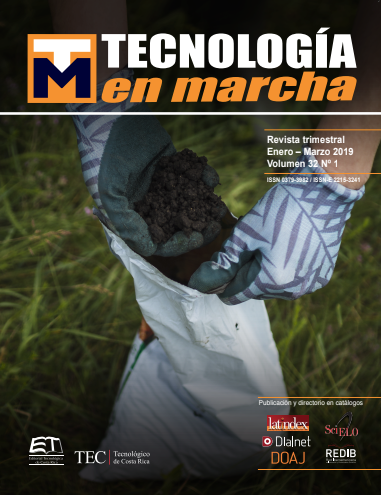Composting of biodegradable wastes from the university restaurant at Tecnológico de Costa Rica
Main Article Content
Abstract
The university restaurant from Tecnológico de Costa Rica ́s main Campus in Cartago, has the purpose of a better waste management; therefore, three composting methods were evaluated to produce organic fertilizer from its biodegradable residues. The researchers selected the techniques through expert ́s opinion, assessing variables like pH, temperature, moisture and efficiency in each technique, in order to determine the most efficient one to re-valorize the organic waste.
A factorial experimental design was selected, in which three treatments were compared: Takakura (TK), Mountain microorganisms (MM) and Pellets (P) with biodegradable solid wastes on each case, in tumbling composters and in pile composters (on the ground), with two repetitions. The used p value was 0,05.
As a result, the Takakura treatment showed the best results from a technical, environmental and economic point of view, since it reached the highest average temperature (53°C) and achieved the thermophilic phase faster than the other ones, maintaining the expected indicators for proper composting, such as a pH close to 7, moisture between 50% and 70% and efficiency of 81%.. Consequently, the researchers conclude this treatment represents a valid strategy to aim towards a circular economy approach at the university ́s restaurant from Tecnológico de Costa Rica.
Article Details
Los autores conservan los derechos de autor y ceden a la revista el derecho de la primera publicación y pueda editarlo, reproducirlo, distribuirlo, exhibirlo y comunicarlo en el país y en el extranjero mediante medios impresos y electrónicos. Asimismo, asumen el compromiso sobre cualquier litigio o reclamación relacionada con derechos de propiedad intelectual, exonerando de responsabilidad a la Editorial Tecnológica de Costa Rica. Además, se establece que los autores pueden realizar otros acuerdos contractuales independientes y adicionales para la distribución no exclusiva de la versión del artículo publicado en esta revista (p. ej., incluirlo en un repositorio institucional o publicarlo en un libro) siempre que indiquen claramente que el trabajo se publicó por primera vez en esta revista.

